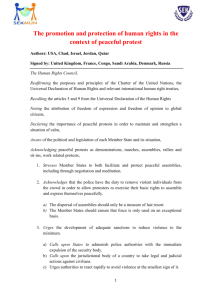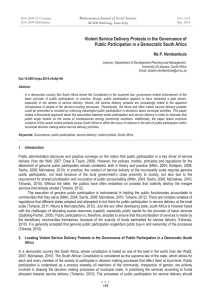Notes - MyWeb
advertisement
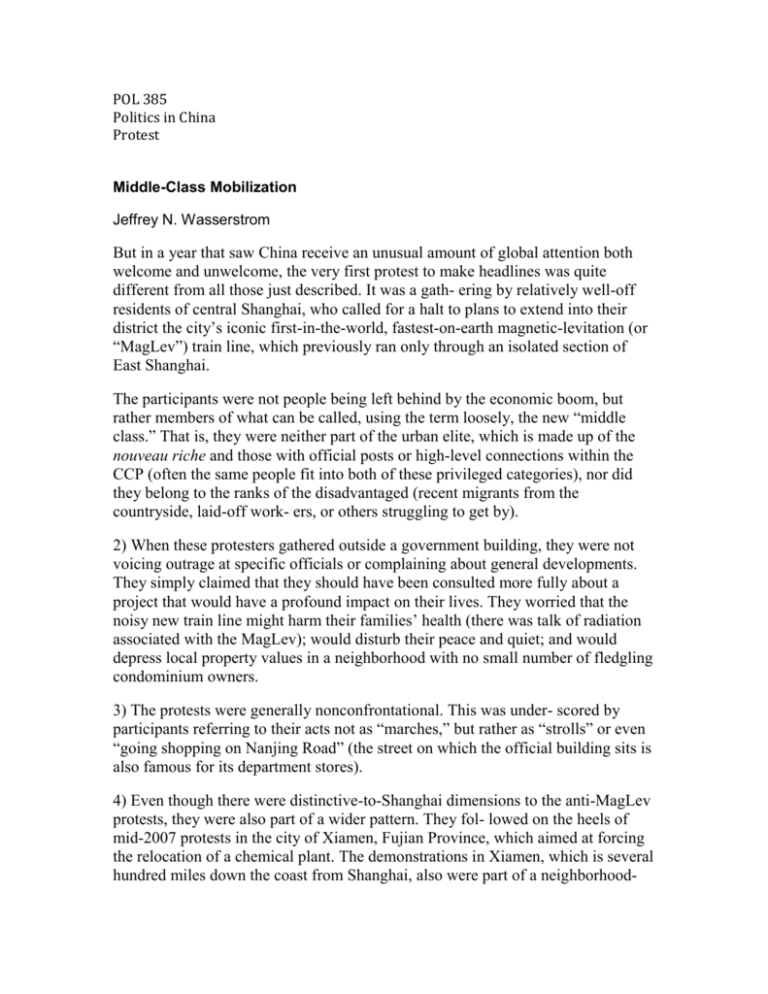
POL 385 Politics in China Protest Middle-Class Mobilization Jeffrey N. Wasserstrom But in a year that saw China receive an unusual amount of global attention both welcome and unwelcome, the very first protest to make headlines was quite different from all those just described. It was a gath- ering by relatively well-off residents of central Shanghai, who called for a halt to plans to extend into their district the city’s iconic first-in-the-world, fastest-on-earth magnetic-levitation (or “MagLev”) train line, which previously ran only through an isolated section of East Shanghai. The participants were not people being left behind by the economic boom, but rather members of what can be called, using the term loosely, the new “middle class.” That is, they were neither part of the urban elite, which is made up of the nouveau riche and those with official posts or high-level connections within the CCP (often the same people fit into both of these privileged categories), nor did they belong to the ranks of the disadvantaged (recent migrants from the countryside, laid-off work- ers, or others struggling to get by). 2) When these protesters gathered outside a government building, they were not voicing outrage at specific officials or complaining about general developments. They simply claimed that they should have been consulted more fully about a project that would have a profound impact on their lives. They worried that the noisy new train line might harm their families’ health (there was talk of radiation associated with the MagLev); would disturb their peace and quiet; and would depress local property values in a neighborhood with no small number of fledgling condominium owners. 3) The protests were generally nonconfrontational. This was under- scored by participants referring to their acts not as “marches,” but rather as “strolls” or even “going shopping on Nanjing Road” (the street on which the official building sits is also famous for its department stores). 4) Even though there were distinctive-to-Shanghai dimensions to the anti-MagLev protests, they were also part of a wider pattern. They fol- lowed on the heels of mid-2007 protests in the city of Xiamen, Fujian Province, which aimed at forcing the relocation of a chemical plant. The demonstrations in Xiamen, which is several hundred miles down the coast from Shanghai, also were part of a neighborhood- specific struggle waged by members of the urban middle class, a social sector that is not only relatively privileged but also unusually adept at using new communications technologies such as text messaging. Following the Shanghai “strolls” (a term that would catch on) came similar mid- 2008 agitations, in the western city of Chengdu and in Beijing soon after the Olympics ended. The driving force in both cases was concern over pollution. I worry that some foreign observers will jump to the wrong conclu- sion when thinking about Chinese middle-class protests, especially if we see more and larger ones in the years to come: namely, that they signal the imminent arrival of the sort of democratic transition that has so often been predicted for China since the 1980s. there are important flaws in this mode of thinking. How justified, for instance, is the assumption that because a number of Leninist regimes fell between 1989 and 1991, communist rule everywhere must be teeter- ing? In Central and Eastern Europe and many parts of the old USSR, communist rule was essentially a foreign imposition. In China, as in Vietnam, Cuba, and North Korea, the communist regime has at least some basis for grounding its claim to legitimacy in its role in a struggle not to impose but to throw off foreign domination. While recent middle-class protests are not signs that a political trans- formation is imminent, they do suggest that China has reached a turning point of sorts. The shift that I have in mind relates to a turn, among rela- tively well-off urbanites, from worrying about urban modernization’s slowness in coming to worrying about urban modernization’s effects on the middle class’s quality of life now that such modernization is here. Rural Protest Kevin J. O'Brien Since then, however, villagers have launched their share of the hundreds of “mass incidents” (quntixing shijian) that occur every day. Whether submitting respectful petitions de- tailing cadre corruption, mounting rightful resistance against illegal fees, or even engaging in violent clashes over land grabs, rural dwellers have shown a willingness to take stronger issue with the powerful than might have been expected in the repressive months following 4 June 1989. This unrest has been triggered in part by a factor familiar to students of political contention: opportunity. Chinese villagers, like the aggrieved anywhere, respond to openings or perceived openings. At a time when the relaxation of official controls over political expression and activ- ity has been fitful and uneven, rural folk have been among the biggest beneficiaries of loosening. More recently, marketization and in- creased mobility have afforded rural people more room in which to ma- neuver, while grassroots elections and legal reforms have provided both new abuses to protest and more safeguards against retaliation. Although many types of claims are still off-limits and Beijing remains unyielding in its hostility to Falun Gong believers, “separatists” in Tibet and Xin- jiang, and anyone who would dare to organize a new political party, top leaders periodically signal that those grievances about which villagers care the most are indeed legitimate. These include concerns related to corruption, selective law enforcement, and people’s livelihoods. As time has passed, more activists have concluded that comparatively tame forms of contention, such as lodging complaints, are ineffective, and that forceful and attention-grabbing tactics (such as blocking a road or organizing a sit-in) are needed. Examples of con- frontational tactics include outfitting pickup trucks with loudspeakers to publicize beneficial policies that have been ignored; demanding meet- ings with schoolmasters to press for the reversal of tuition hikes; and surrounding fee collectors as a prelude to driving them off. Whereas protest leaders in earlier years typically turned to higher-level officials in order to ask for help in cleaning up local misconduct, more are now willing to challenge powerholders directly and seek concessions on the spot. Violence is also on the rise. A number of clashes between farmers and local authorities have taken place recently over issues such as locating a power plant on village land, or refusing to allow the recall of a corrupt official. More than a few of these incidents have led to significant casualties after armed police or local toughs arrived to repress the protesters. At the same time, Yu Jianrong, a researcher at the Chinese Academy of Social Sciences, has documented the spread of unplanned, “accidental” protests that rapidly take on a life of their own. These “angerventing” flare-ups are often touched off by essentially random sparks. is rural China about to explode? Not likely. Most contention remains weakly organized, and cooperation across class lines is still rare—though involvement of public intellectu- als and “rights-protection lawyers” (weiquan lüshi) in rural protest has increased. Claims tend to be circumscribed and popular action is usually small-scale and local. Even taking into account developments such as calls to privatize farmland that swept Heilongjiang, Henan, and Inner Mongolia in 2008, wide-ranging demands and long-lasting leadership are the exception, and there are few signs of the solidarity, scope, and coordination that a sustained social movement would require. Rural protest plays a role in fending off extraction, deflecting predatory behavior, and sending unpopular cadres packing, but there is little evidence that it poses an imminent threat to the regime. That the Communist Party hierarchy tolerates so much rural contention is a sign of the Party’s confidence. As with the dash of account- ability offered by village elections, permitting a dollop of dissent is an element of the regime’s high-wire legitimation strategy, and it reflects faith that things can be kept in hand. The authorities still have enormous powers of repression at their disposal, and they can unleash disproportionate force if they conclude that core interests are at stake. MOUNTING CHALLENGES TO GOVERNANCE IN CHINA: SURVEYING COLLECTIVE PROTESTORS Jae Ho Chung;Lai, Hongyi;Xia, Ming What does the data on protest show? Include both protest, religious groups and crime. Collective public security incidents CoPSI 10X increase from 1993 – 2005 and the number of persons involved have risen even faster – to several millions Spread over the entire nation – urban and rural and have become increasingly violent and confrontational Unemployment, bankruptcy, financial scams in urban areas Land disputes in rural areas Greatest part of protests were directed at ineffective and unresponsive local officials Rapid expansion of religious organizations and activity and in connection to the Falun Gong many protests develop Reform and the decline of controls leads to a return of criminal activity and organizations Links to and bribery of local officials to gain protection Linkages between protest, religious protest and criminal activity: Religious groups, criminal organization and kinship groups Criminal groups control state officials who engage in land thefts that provoke protests Criminal groups organize protests to reduce state capacity to act against them Pages 29-30 “For the weak and the lost in China…”
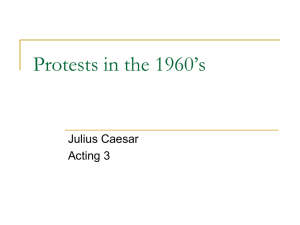
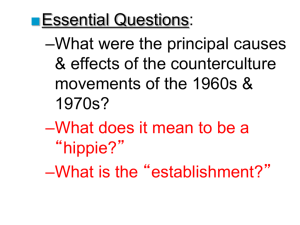

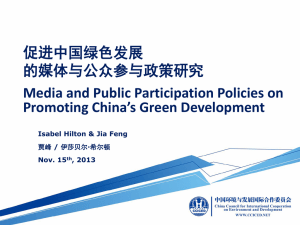
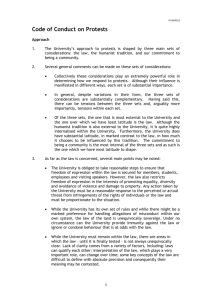

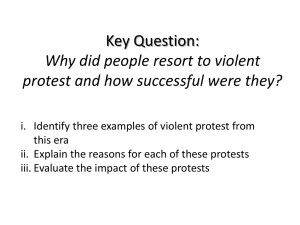
![The Politics of Protest [week 3]](http://s2.studylib.net/store/data/005229111_1-9491ac8e8d24cc184a2c9020ba192c97-300x300.png)


